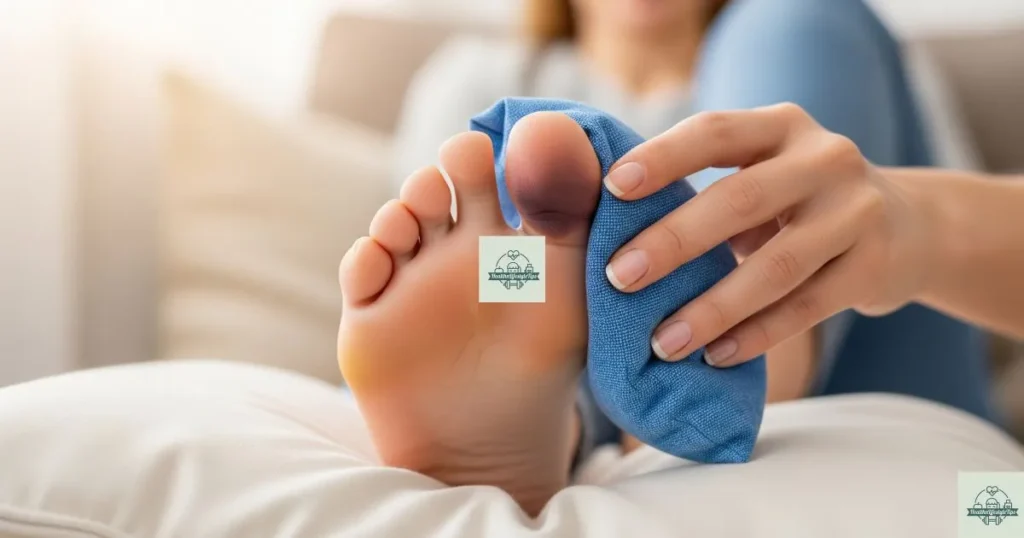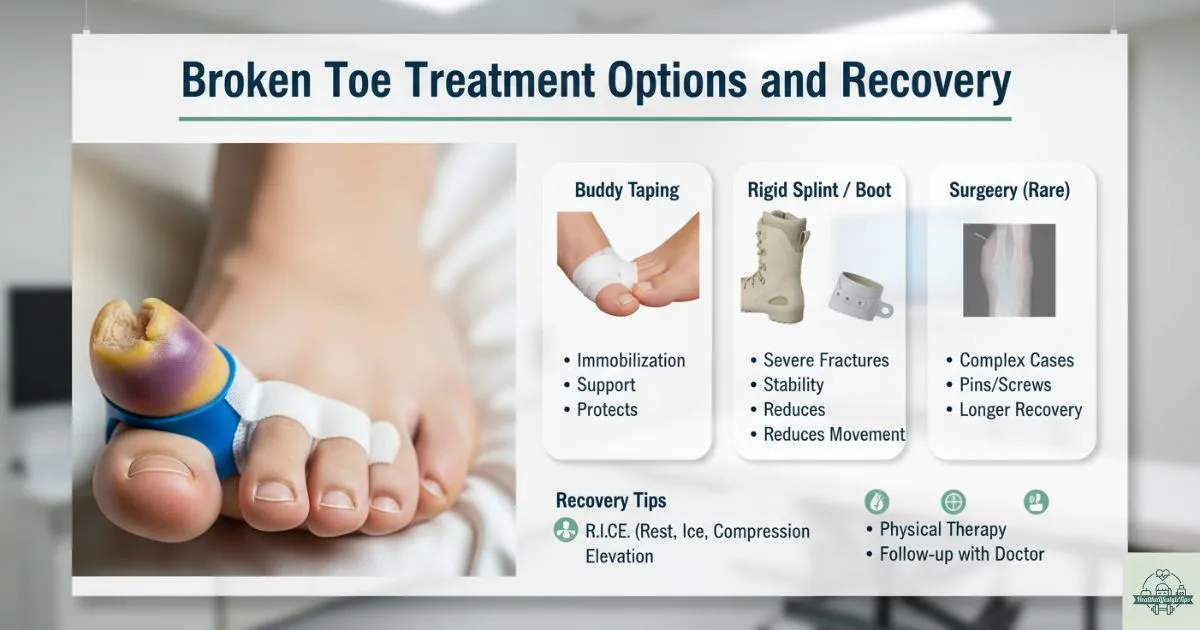Ouch! That sudden, sharp pain after stubbing your toe on the leg of a chair is a feeling we all know too well. Sometimes, after a few minutes of hopping around, the pain fades, and we forget all about it. But what happens when that pain sticks around? It might be more than just a simple bump; you could be dealing with a broken toe.
A broken toe happens when one of the small bones in your toe cracks or breaks. It’s a super common injury that can happen to anyone, whether you’re a kid playing tag or an adult just walking through a dark room. While it may seem like a minor problem, ignoring it can lead to more significant issues down the road, such as lasting pain or a toe that heals in a crooked manner. Taking care of it correctly from the start is the key to getting back on your feet, pain-free.
At-Home Care for a Broken Toe

Good news! You can start treating a broken toe right at home. A significant first step is the R.I.C.E. method: Rest your foot, put Ice on it for 20 minutes at a time, compress it with a light wrap, and elevate your foot on a pillow.
Another helpful trick is “buddy taping,” where you tape the injured toe to the one next to it for support. For pain, over-the-counter medicine like ibuprofen can help you feel much more comfortable.
Medical Treatment Options
Sometimes, home care isn’t quite enough, and you might need a doctor’s help. If the bone is out of place, a doctor may need to reposition it in a process called reduction, gently.
To keep your toe from moving while it heals, you might get a special stiff-bottomed shoe or a splint. For a more serious broken toe, a surgeon may need to use tiny pins or screws to hold the bone together so it heals perfectly straight.
Recovery Timeline and Tips
Patience is key when you’re healing! Most broken toes typically take 4 to 6 weeks to recover fully. To help speed things up, make sure you rest your foot as much as possible.
When you do walk, wear sturdy, comfortable shoes that give your toes plenty of room—no squishing! Once your doctor gives you the green light, gentle exercises, such as wiggling your toes, can help restore strength and movement. Following these tips will get you back in action sooner.
When to See a Doctor

While home care is excellent, there are times when you absolutely need to see a doctor. If the pain is unbearable, your toe appears very crooked, or you have an open wound near the injury, it’s time to seek professional help.
Also, look out for signs of infection, like redness that spreads, warmth, or a fever. Numbness or a tingling feeling in your toe is another big red flag. Don’t wait—seeing a doctor ensures your broken toe heals correctly and without complications.
Prevention Tips
Nobody wants to deal with a broken toe, and a few smart habits can help you avoid one. Always wear sturdy, closed-toe shoes, especially when you’re working with heavy items or walking in cluttered areas. If you play sports, make sure your footwear is right for the activity.
It’s also essential to keep your bones strong by getting enough calcium and vitamin D in your diet. And a simple tip? Turn on a light at night to avoid bumping into things in the dark.
Also Read: Comprehensive Guide to Flat Feet and When to See a Podiatrist
Symptoms of a Broken Toe
So, how is it really a broken toe? Your body will give you some clear clues. The first thing you’ll notice is a deep, throbbing pain that doesn’t go away. Your toe will likely swell up like a little balloon and might turn purple, blue, or black from bruising.
Sometimes, the toe will look crooked or out of place, which is a sure sign that something is wrong. Trying to move it or even touching it can be excruciating. If you’re experiencing these symptoms, it’s a good idea to treat them seriously.
Causes of a Broken Toe
How does this painful injury happen? Getting a broken toe is often easier than you’d think. The most classic cause is stubbing your toe with all your might against something hard, like furniture. Another common culprit is dropping a heavy object, such as a can of soup or a book, directly onto your foot.
But it’s not always a sudden accident. Sometimes, doing the same motion over and over, like running long distances without the right shoes, can cause tiny cracks in the bone. This is called a stress fracture, and it can be just as painful.
Also Read: Comprehensive Guide to Ankle Rashes
Diagnosis: How to Confirm a Broken Toe
If you think you have a broken toe, a trip to the doctor can give you a clear answer. The doctor will gently examine your toe for swelling, bruising, and any areas of soreness. They’ll want to see how well you can move it and make sure everything looks aligned.
To get a peek inside, they will likely order an X-ray. This special picture shows the bones in your foot and will confirm if a bone is actually broken and how serious the break is.
Also Read: Broken or Bruised Toe?
FAQs
Can you walk on a broken toe?
It might be possible, but it’s not a good idea. Walking on it can make the injury worse and slow down healing. It’s best to rest it as much as you can.
How do you know if your toe is broken or just bruised?
It’s tricky because they have similar symptoms. A big clue is if your toe looks crooked or if you heard a “pop” sound when it happened. An X-ray is the only way to know for sure.
How can I tell if my toe is broken or just badly bruised?
It can be tough to tell the difference because both can cause pain, swelling, and bruising. A big clue for a break is if the toe looks crooked or bent out of shape, or if you heard a “popping” sound during the injury. However, the only way to be 100% sure is to see a doctor for an X-ray.
What should I do right after I think I’ve broken my toe?
You can start by using the R.I.C.E. method: Rest your foot, apply Ice for 20 minutes at a time, use a light bandage for Compression, and elevate your foot above your heart. You can also tape the injured toe to the one next to it (buddy taping) for support.
How long does it take for a broken toe to heal?
Most broken toes heal within 4 to 6 weeks. The exact time depends on how bad the break is and how well you take care of it. Following your doctor’s advice and getting plenty of rest will help you heal as quickly as possible.
Do I always need to see a doctor for a broken toe?
While many minor toe fractures heal well at home, you should see a doctor if the pain is severe, the toe looks crooked, there’s an open wound near the break, or if you have numbness or tingling. A doctor can make sure it heals correctly and prevent future problems.
Conclusion
Dealing with a broken toe can be a real pain, but now you know exactly what to do. From spotting the first signs of trouble, such as swelling and bruising, to using the R.I.C.E. method at home, you’re equipped to handle it. Remember, while many cases heal with rest and buddy taping, it’s essential to see a doctor if the pain is severe or the toe looks out of place. By taking good care of your feet and following these tips, you can ensure your toe heals correctly and get back to your activities without missing a step.
